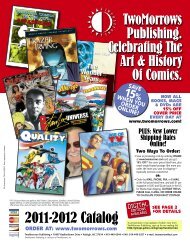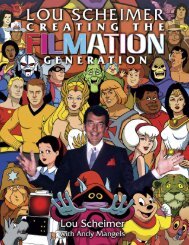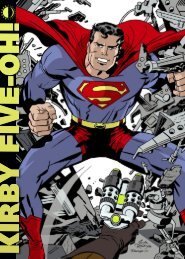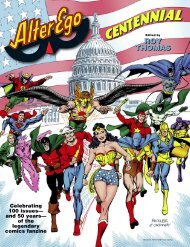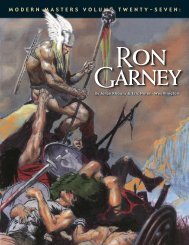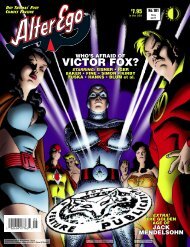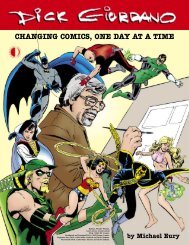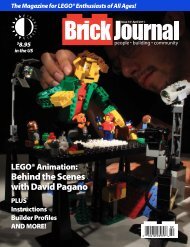JENETTE KAHN - TwoMorrows Publishing Store
JENETTE KAHN - TwoMorrows Publishing Store
JENETTE KAHN - TwoMorrows Publishing Store
Create successful ePaper yourself
Turn your PDF publications into a flip-book with our unique Google optimized e-Paper software.
Marcia, Marcia,<br />
Marcia…<br />
…and the rest of the<br />
Brady Bunch (with<br />
Geri Reischl as a fill-in<br />
Jan) made the cover<br />
of Dynamite #2,<br />
promoting the<br />
short-lived 1976 TV<br />
series, The Brady<br />
Bunch Variety Hour.<br />
(right) Thor’s origin<br />
is revealed to<br />
Dynamite readers<br />
in a “Super-Heroes<br />
Confidential.”<br />
Dynamite © Scholastic.<br />
Brady Bunch TM & © Paramount.<br />
Thor TM & © Marvel Characters, Inc.<br />
On the same trip I made to New York to see Joe,<br />
I also met with Pat Carbine at Look Magazine. Not long<br />
after, Look published an article featuring our very young<br />
editors and artwork from Kids, and then Time magazine<br />
followed suit with an article of its own. After that, it was a<br />
series of falling dominoes as media across the country<br />
seized upon the story. Not only did dozens of newspapers<br />
cover Kids, but our editors were on The David Frost Show<br />
and I was even the real Jenette Kahn on To Tell the Truth.<br />
Everybody guessed me, but I consoled myself by<br />
saying if someone else were a better Jenette Kahn than I,<br />
I would be severely depressed. [mutual chuckling]<br />
And that was how Kids was launched. It was an<br />
extraordinary critical success and an equally large financial<br />
disaster. Neither I nor James Robinson knew anything<br />
about business and we had no money to fund the<br />
magazine. But Kids continued to publish because<br />
we had Dale Bowman, our incredible printer who<br />
believed in us and believed in Kids and kept extending<br />
us credit. But at issue #6, he could no longer afford to<br />
do that. I was 23 years old, owed a hundred thousand<br />
dollars, and knew everything about Chapter Ten versus<br />
Chapter Eleven bankruptcy. But even with this<br />
catastrophe, publishing was in my blood. [laughs]<br />
GREENBERGER: Oh, God! So it went from Kids and<br />
based on all that, you learned your lesson and got<br />
into Dynamite?<br />
<strong>KAHN</strong>: Unfortunately, I ended up on the wrong side of<br />
a creditor’s table, settling for 20 cents on the dollar,<br />
and we sold Kids to another company. But as I said,<br />
publishing was in my blood and I wanted to create a<br />
second magazine. Even though Kids was a financial<br />
calamity, it had gotten a huge amount of attention and<br />
was very highly thought of. Executives at Scholastic were<br />
acutely aware of Kids and asked if I would conceive another<br />
magazine for them. It was just what I wanted to do.<br />
I named the magazine Dynamite and presented the<br />
concept to Dick Robinson, who was the head of the<br />
company. Dynamite was a departure for Scholastic and<br />
Dick wasn’t ready to make a full commitment, but he<br />
decided to publish three issues and judge its success or<br />
failure from them.<br />
One of our many mistakes with Kids was putting it<br />
on the newsstand. Magazines suffered on the newsstands<br />
where millions of magazines were returned, many of<br />
them without ever being displayed. Compounding<br />
this, children didn’t frequent newsstands and their<br />
parents who did were looking for Newsweek, Time, and<br />
Forbes, not magazines for their kids. We were lucky<br />
if we sold 20 percent of our press run.<br />
But Dynamite wasn’t sold on the newsstand but<br />
through the Scholastic Book Clubs, an equivalent to<br />
the direct market in comic books. Using teachers as<br />
their middlemen, Scholastic would send brochures to a<br />
classroom with small capsule write-ups of the books of<br />
that month. The students would check off the books they<br />
wanted to read and return with money from their parents<br />
to purchase them. The teachers would collect the money<br />
and send it back to Scholastic. With this system, Scholastic<br />
was able to tally in advance the number of requests for<br />
each book and print each title to order. Unlike the newsstand,<br />
it was an enviable business, a business of no returns.<br />
Despite Dick Robinson’s initial tentativeness,<br />
Dynamite changed the fortunes of Scholastic, becoming<br />
the bestselling publication of its 32 magazines and the<br />
most successful publication in its history. Although I<br />
didn’t benefit financially from Dynamite’s enormous<br />
success, it changed my fortunes, too, opening up new<br />
career paths for me.<br />
GREENBERGER: During the first year of Dynamite,<br />
there was a three-page feature called “Super-Heroes<br />
Confidential,” where you had excerpts, featuring origins<br />
6 • B A C K I S S U E • J e n e t t e K a h n I s s u e



